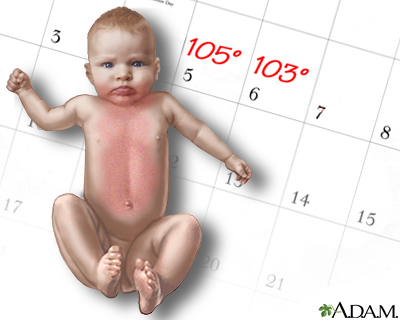Roseola
Exanthem subitum; Sixth disease
Roseola is a viral infection that commonly affects infants and young children. It involves a pinkish-red skin rash and high fever.
Images


I Would Like to Learn About:
Causes
Roseola is common in children ages 3 months to 4 years, and most common in those ages 6 months to 1 year.
It is caused by a virus called human herpesvirus 6 (HHV-6), although similar syndromes are possible with other viruses.
Symptoms
The time between becoming infected and the beginning of symptoms (incubation period) is 5 to 15 days.
The first symptoms include:
- Eye redness
- Irritability
- Runny nose
- Sore throat
- High fever, that comes on quickly and may be as high as 105°F (40.5°C) and can last 3 to 7 days
About 2 to 4 days after becoming sick, the child's fever lowers and a rash appears. This rash most often:
- Starts on the middle of the body and spreads to the arms, legs, neck, and face
- Is pink or rose-colored
- Has small sores that are slightly raised
The rash lasts from a few hours to 2 to 3 days. It usually does not itch.
Exams and Tests
Your health care provider will perform a physical exam and ask questions about the child's medical history. The child may have swollen lymph nodes in the neck or back of the scalp.
Treatment
There is no specific treatment for roseola. The disease most often gets better on its own without complications.
Acetaminophen (Tylenol) and cool sponge baths can help reduce the fever. Some children may have seizures when they get a high fever. If this occurs, call your provider or go to the closest emergency room.
Possible Complications
Complications may include:
- Aseptic meningitis (rare)
- Encephalitis (rare)
- Febrile seizure
When to Contact a Medical Professional
Contact your provider if your child:
- Has a fever that does not go down with the use of acetaminophen (Tylenol) or ibuprofen (Advil) and a cool bath
- Continues to appear very sick
- Is irritable or seems extremely tired
Go to the emergency room or call the local emergency number (such as 911) if your child has convulsions.
Prevention
Careful handwashing can help prevent the spread of the viruses that cause roseola.
Related Information
RashesFebrile seizures
References
Cherry J. Roseola infantum (exanthem subitum). In: Cherry JD, Harrison GJ, Kaplan SL, Steinbach WJ, Hotez PJ, eds. Feigin and Cherry's Textbook of Pediatric Infectious Diseases. 8th ed. Philadelphia, PA: Elsevier; 2019:chap 59.
Tesini BL, Caserta MT. Roseola (human herpesviruses 6 and 7). In: Kliegman RM, St. Geme JW, Blum NJ, Shah SS, Tasker RC, Wilson KM, eds. Nelson Textbook of Pediatrics. 21st ed. Philadelphia, PA: Elsevier; 2020:chap 283.
BACK TO TOPReview Date: 8/5/2023
Reviewed By: Neil K. Kaneshiro, MD, MHA, Clinical Professor of Pediatrics, University of Washington School of Medicine, Seattle, WA. Also reviewed by David C. Dugdale, MD, Medical Director, Brenda Conaway, Editorial Director, and the A.D.A.M. Editorial team.

Health Content Provider
06/01/2025
|
A.D.A.M., Inc. is accredited by URAC, for Health Content Provider (www.urac.org). URAC's accreditation program is an independent audit to verify that A.D.A.M. follows rigorous standards of quality and accountability. A.D.A.M. is among the first to achieve this important distinction for online health information and services. Learn more about A.D.A.M.'s editorial policy, editorial process and privacy policy. A.D.A.M. is also a founding member of Hi-Ethics. This site complied with the HONcode standard for trustworthy health information from 1995 to 2022, after which HON (Health On the Net, a not-for-profit organization that promoted transparent and reliable health information online) was discontinued. |
The information provided herein should not be used during any medical emergency or for the diagnosis or treatment of any medical condition. A licensed medical professional should be consulted for diagnosis and treatment of any and all medical conditions. Links to other sites are provided for information only -- they do not constitute endorsements of those other sites. © 1997- 2025 A.D.A.M., a business unit of Ebix, Inc. Any duplication or distribution of the information contained herein is strictly prohibited.
